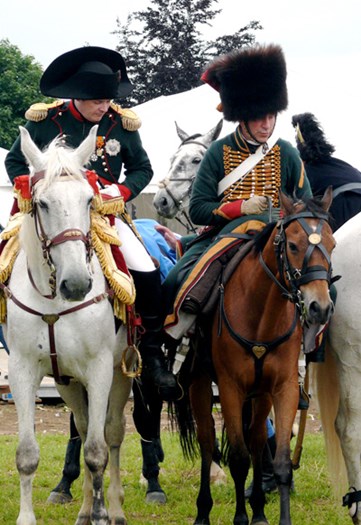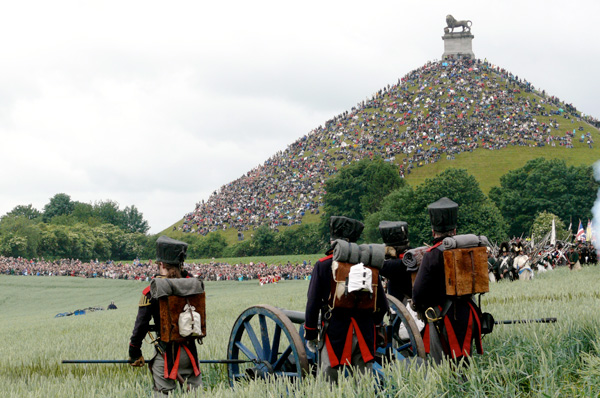WATERLOO, BELGIUM – The intermittent rain and icy wind doesn’t seem to be dampening the spirit of the thousands marching toward one of history’s greatest battlefields.
Souad Mimouni, the Belgian friend who has driven me to this quaint town just 12 kilometres from downtown Brussels to view a reenactment of the Battle of Waterloo, parks her car and we join the march.
The wind whips up the soon-to-be-harvested oats growing in the fields where the battle was originally fought in 1814 and the wavy effect the wind creates makes it appear we’re heading toward a giant green lake.
“History is repeating itself,” says the charming Souad as she wraps a scarf around her neck for protection against the unseasonable weather. “I recall from my history lessons that it was a cold, windy, rainy day just like this when the Battle of Waterloo took place.”
That day was June 18th, 1815 – and on the same date 195 years later the reenactment is being played out for over 40,000 history buffs.
As we approach a spot where historians say the 10 hour battle was fought between Emperor Napoleon Bonaparte’s 200,000-man strong French army and the Duke of Wellington’s ill-equipped and badly trained Allied forces, consisting of 160,000 British, Belgian, Dutch and Prussian troops, Souad remembers reading about a local farmer who toured the battlefield the day after the conflict as saying the field was soaked with rain water and blood and that the horses’ hoofs had trampled the grain into dough.


Left: Even Emperor Napoleon Bonaparte makes an appearance. Right: Thousands watch the battle on nearby hills.
That’s what happens when the blood of more than 61,000 men – the number of soldiers who were reportedly wounded or killed in the brief conflict - is spilled; not to mention the thousands of horses that perished in the fight, as well.
“I hope that will not be the case today,” smiles Souad about the reenactment that is about to be played out a small portion of the battlefield, which was originally spread over 14 square kilometres.
The reenactments are actually held every five years by some 3,000 actors wearing period uniforms. They use replica guns and canons and lots of controlled explosions to make the whole thing look and sound real.
As the battlefield comes into view, one cannot but be impressed with the giant memorial built to commemorate the epic battle.
“That is Belgium’s pyramid,” says Souad about the handsome Lion Monument that was erected by the Dutch to mark the spot where their Prince of Orange was wounded during the conflict. The earth from the original battlefield was pushed together into one giant 40-metre-high mound and topped off with a 28-tonne cast-iron lion. There are a number of other impressive monuments scattered about the site marking key points of the battle but nothing else compares to the Lion Monument.
On this day, spectators climb the many stairs leading to the top and then take up positions on the mound to get a better view of the reenactment.
“They look like ants on an ant hill,” says Souad as we purchase our tickets, head to our seats in one of the makeshift grandstands, and wait for the battle to begin.
Throughout history, Belgian towns have been “ground zero” for some of the greatest European military battles – Flanders in World War I; Bastogne in WW II – but none was more significant than the Battle of Waterloo.
Two kilometers from the centre of this small town, which has become a chic suburb for bustling Brussels, the capital of both Belgium and the European Union and headquarters of NATO, Napoleon’s reign as Emperor of France came to an end with his defeat at the hands of Wellington.
It was after this defeat that Napoleon was exiled to Saint Helena where he died in 1821.
For his part, the victorious Duke of Wellington, a.k.a. Arthur Wellesley, went on to become England’s prime minister in 1830 and presided over a conference of European powers – the original EU - that eventually brought about Belgium’s independence from the Netherlands.
The time has come for the troops to assemble – to the right of us the actor playing Wellington and his forces trudge waist-deep into the grain field and take up defensive positions; straight ahead, we see Napoleon – in a powder blue uniform worthy of every French fashion designer’s seal of approval – position his forces.
Drums roll; bugles blare; musket shots ring out; horses hoofs create a thunderous sound; an unexpected canon blast stuns the crowd – the reenactment is under way.
For the next two hours, the 3,000 actors, accompanied by hundreds of horses, keep the crowd on the edge of their seats with a performance deserving of the standing ovation they get at the end.
In the real battle of 1815, Wellington was headed for almost certain defeat but, thanks to some brilliant early maneuvering on his part and some bone-head Bonaparte blunders, the Duke was able to hold off the French long enough for the Prussian army reinforcements to ride to the rescue.
On cue, the Prussian actors arrive; the battle is won; the reenactment is over. No soldiers die – one horse is slightly injured when it sprains its leg while charging through the field of long grain.
“I wish all wars could end like this,” says Souad as we scurry from the bleacher in search of a place to warm ourselves.
“I think it best we go into Waterloo centre and have a coffee,” says Souad, who adds, “there we can visit the Wellington Museum.”
The small museum has become the main attraction between reenactments for the thousands who visit Waterloo, a town that has tripled in size since 1960.
Originally a coach house, Wellington commandeered the premises and turned it into his headquarters on June 17, 1815. That evening, he and his generals planned their strategy for the next day. The original desk, on which he wrote his victory communiqué to London the evening of June 18 after the battle, holds a place of prominence in the room that served as his bedroom at the time.
In all, 14 rooms make up the small but fascinating museum where priceless prints and paintings of the battle hang – the most impressive is one of Wellington sitting atop his favourite steed, Copenhagen; the horse he rode into battle at Waterloo. Artifacts from the battle that make up the Wellington exhibition include:
- A breast plate perforated by a bullet near the heart – probably causing a fatal wound to the unknown soldier who wore it;
- A travelling pistol belonging to a key player in the original battle, Count van der Burch;
- Swords and flint-lock pistols used by the Anglo-Dutch forces that made up the largest part of Wellington’s Allied Army;
- The dispatch box of Sir Alexander Gordon, Wellington’s aide-de-camp who was fatally injured but waited to hear the final outcome of the battle before slipping into death;
- A wooden leg Lord Uxbridge used after having his leg amputated in the Maison Paris, a stunning building that sits directly across from the Wellington Museum and served as a hospital during the battle;
- A replica of a nine-pound cannon used by the Royal Artillery at Waterloo;
- A cape worn by the Duke of Wellington during the Spanish campaign (1809 to 1813);
- Excerpts from an unknown English officer’s diary.
It’s all very impressive.
Over coffee and cake at the patisserie right next to the museum, Souad says elaborate plans are already under way for the 200th anniversary to be held in 2015.
But while the reenactments are special events that help modern-day history buffs get a taste for what the real event was like, staying away from Belgium and the other wonders it offers, will be tough.
"Good," says Souad of my plans to return to Belgium well before 2015, "because Belgium has a lot more to offer you."